Monthly Archives: April 2018
 With new technology, always comes some risk of failure. Sometimes, the the failure doesn’t hurt anything, but other times, it can be deadly. In the world of submarines, the atomic submarine was the latest thing in the 1960s. The USS Thresher was launched on July 9, 1960, from Portsmouth Naval Yard in New Hampshire. It was built with the latest technology, and was the first submarine assembled as part of a new class that could run more quietly and dive deeper than any that had come before it. The designers and the Navy expected great things from Thresher, and initially, the submarine met their expectations.
With new technology, always comes some risk of failure. Sometimes, the the failure doesn’t hurt anything, but other times, it can be deadly. In the world of submarines, the atomic submarine was the latest thing in the 1960s. The USS Thresher was launched on July 9, 1960, from Portsmouth Naval Yard in New Hampshire. It was built with the latest technology, and was the first submarine assembled as part of a new class that could run more quietly and dive deeper than any that had come before it. The designers and the Navy expected great things from Thresher, and initially, the submarine met their expectations.
Then on April 10, 1963, at just before 8am, the Thresher was conducting drills off the coast of Cape Cod. At 9:13am, the USS Skylark, another ship participating in the drills, received a communication from the Thresher that the sub was experiencing 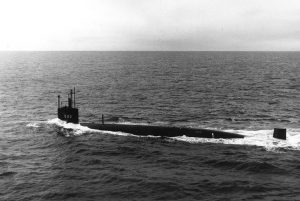 minor problems. Unfortunately, the minor problems turned into a very major problem…almost instantly. Other attempted communications with Thresher failed and, only five minutes later, sonar images showed the Thresher breaking apart as it fell to the bottom of the sea, 300 miles off the coast of New England. Sixteen officers, 96 sailors and 17 civilians were on board. All were killed.
minor problems. Unfortunately, the minor problems turned into a very major problem…almost instantly. Other attempted communications with Thresher failed and, only five minutes later, sonar images showed the Thresher breaking apart as it fell to the bottom of the sea, 300 miles off the coast of New England. Sixteen officers, 96 sailors and 17 civilians were on board. All were killed.
On April 12, President John F. Kennedy ordered that flags across the country be flown at half-staff to commemorate the lives lost in this disaster. A subsequent investigation revealed that a leak in a silver-brazed joint in the engine room had caused a short circuit in critical electrical systems. The problems quickly spread, making the equipment needed to bring the Thresher to the surface inoperable. The submarine went into a freefall to the bottom. There was no time to do anything to stop it or find a way of escape…if one existed.
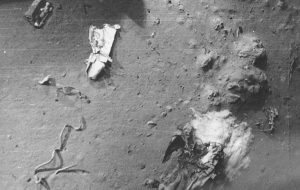
The disaster forced improvements in the design and quality control of submarines. Twenty-five years later, in 1988, Vice Admiral Bruce Demars, the Navy’s chief submarine officer, said “The loss of Thresher initiated fundamental changes in the way we do business–changes in design, construction, inspections, safety checks, tests, and more. We have not forgotten the lessons learned. It’s a much safer submarine force today.” I don’t think there was necessarily anything that was done so wrong that it could have prevented what happened, but I could be wrong. Obviously, there is always room for improvement in any design, but unfortunately, sometimes the only way to know that an improvement is needed, is to have a disaster strike.
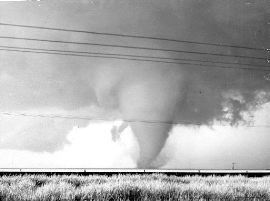 When I think of Tornado Alley, Oklahoma is always among the states that come to mind, but I didn’t know which tornado would be considered the worst one in the states history. Nor did I know that the 1947 Woodward Tornado would continue to hold that status year after year. The most deadly tornado to ever strike within the borders of the state of Oklahoma occurred on Wednesday, April 9, 1947 in the city of Woodward, and across Texas and Kansas. The Woodward tornadic storm actually began in the Texas Panhandle that afternoon, and produced at least six tornadoes along a 220 mile path that stretched from White Deer, Texas, northeast of Amarillo, to Saint Leo, Kansas, west of Wichita.
When I think of Tornado Alley, Oklahoma is always among the states that come to mind, but I didn’t know which tornado would be considered the worst one in the states history. Nor did I know that the 1947 Woodward Tornado would continue to hold that status year after year. The most deadly tornado to ever strike within the borders of the state of Oklahoma occurred on Wednesday, April 9, 1947 in the city of Woodward, and across Texas and Kansas. The Woodward tornadic storm actually began in the Texas Panhandle that afternoon, and produced at least six tornadoes along a 220 mile path that stretched from White Deer, Texas, northeast of Amarillo, to Saint Leo, Kansas, west of Wichita.
The town of Woodward, Oklahoma was hit head on, and was nearly wiped off the map by the powerful tornado. More than 100 people died in Woodward, and 80 more lost their lives 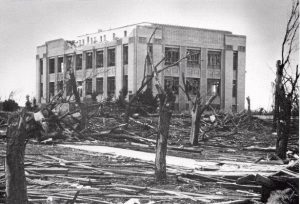 elsewhere in the series of twisters that hit the heartland of the United States that day. The tornado that struck Woodward actually began near Canadian, Texas. It moved northeast, continuously on the ground for about 100 miles, ending in Woods County, Oklahoma, west of Alva. The tornado was massive, measuring up to 1.8 miles wide, and moved along its path at speeds of about 50 miles per hour. It first struck Glazier and Higgins in the Texas Panhandle, bringing devastation to both towns and killing at least 69 people in Texas before crossing into Oklahoma. In Ellis County, Oklahoma, the tornado did not strike any towns, passing to the southeast of Shattuck, Gage, and Fargo. Nevertheless, while no towns were struck, 60 farms and ranches were destroyed and 8 people were killed and 42 injured. In Woodward County, one death was reported near Tangier.
elsewhere in the series of twisters that hit the heartland of the United States that day. The tornado that struck Woodward actually began near Canadian, Texas. It moved northeast, continuously on the ground for about 100 miles, ending in Woods County, Oklahoma, west of Alva. The tornado was massive, measuring up to 1.8 miles wide, and moved along its path at speeds of about 50 miles per hour. It first struck Glazier and Higgins in the Texas Panhandle, bringing devastation to both towns and killing at least 69 people in Texas before crossing into Oklahoma. In Ellis County, Oklahoma, the tornado did not strike any towns, passing to the southeast of Shattuck, Gage, and Fargo. Nevertheless, while no towns were struck, 60 farms and ranches were destroyed and 8 people were killed and 42 injured. In Woodward County, one death was reported near Tangier.
The storm occurred when a cold front from Siberia met a warm and moist stream of air from the Gulf of Mexico, 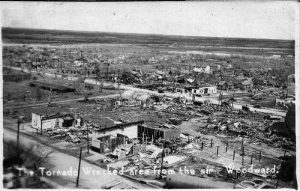 and into Texas. By the time it reached Woodward, some estimated that it was as big as two miles wide. As the storm moved through Woodward, 200 residential blocks were completely leveled and nearly 1,000 homes were razed. Fires broke out in several spots but the heavy rains kept them under control. In all, 107 people were killed in Woodward and many more were injured. The devastating tornado then continued on to Kansas, where significant damage was done but no one was killed. When looting was reported in the areas hit by the tornado, the National Guard was called in to restore order. Army barracks were used to house the homeless until their homes could be rebuilt. Damage caused by this event totaled about $9,700,000.
and into Texas. By the time it reached Woodward, some estimated that it was as big as two miles wide. As the storm moved through Woodward, 200 residential blocks were completely leveled and nearly 1,000 homes were razed. Fires broke out in several spots but the heavy rains kept them under control. In all, 107 people were killed in Woodward and many more were injured. The devastating tornado then continued on to Kansas, where significant damage was done but no one was killed. When looting was reported in the areas hit by the tornado, the National Guard was called in to restore order. Army barracks were used to house the homeless until their homes could be rebuilt. Damage caused by this event totaled about $9,700,000.
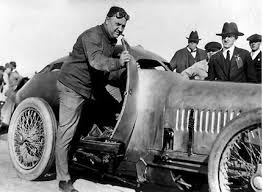 Since there were ways to race, people have been racing. From chariot races to horse races, people soon acquired a taste for speed and for competition. That has never gone away, even though some have paid a dear price for it. When the automobile was invented, it didn’t take long to get to the point of challenges and races. At first, these races took place on he city streets or on highways, but eventually they knew that there had to be a safer way to race.
Since there were ways to race, people have been racing. From chariot races to horse races, people soon acquired a taste for speed and for competition. That has never gone away, even though some have paid a dear price for it. When the automobile was invented, it didn’t take long to get to the point of challenges and races. At first, these races took place on he city streets or on highways, but eventually they knew that there had to be a safer way to race.
The first organized race of the “horseless carriages,” as they were called, was held in France in 1894. The winning speed was less than 10 miles per hour and the winner was disqualified because his steam-driven tractor was deemed not to be a practical vehicle. To me, the whole race was laughable. Ten miles per hour is hardly what I would call a race. The final straw came on April 8, 1916, at the Boulevard Race in Corona, California, when an early racing car driver lost control and careened into a crowd of spectators. The 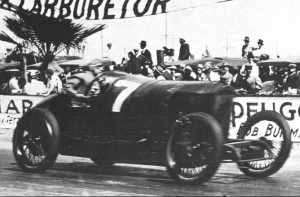 accident killed the driver and two other people. At that time, these racing events were still pretty rare, and this fatal accident encourage organizers to find a better place to hold car races. They came up with the idea of specially built tracks, instead of regular streets.
accident killed the driver and two other people. At that time, these racing events were still pretty rare, and this fatal accident encourage organizers to find a better place to hold car races. They came up with the idea of specially built tracks, instead of regular streets.
While it would seem like things would really get going after that, I wasn’t until twelve years later that the first Grand Prix was held. As time went on and speeds increased, the races became more dangerous. The deadly 1916 Corona Boulevard Race took place on Grand Boulevard in Corona, just east of Los Angeles. “Wild Bob” Burman, had previously set a world speed record for hitting 129 miles per hour. He was driving a blue Peugeot, and leading the race. Burman lost control when a wheel broke and his car crashed through a barrier. Burman died in the accident, along with his ride-along mechanic and a spectator. Five other people in the crowd were seriously injured.
Other racing events that followed, have been even more deadly. When a car crashed into a spectator area at  the 1955 Le Mans, 80 people were killed. Two years later in Italy, 10 spectators were killed at Mille Miglia. I was the last time that race was run. In July 1996, three separate races on the same day claimed victims among the spectators. But, probably the most dangerous of all races has been the off-road Dakar Rally. The best guess is that 47 competitors have been killed in the race’s 27 year history and many more spectators have also lost their lives. The original Dakar Rally ran from Paris to Dakar, Senegal, but fatal accidents in France forced a change in course. The routes have varied since 1999. Modifications have been made over the years to reduce the risk to the public, but drivers remained vulnerable, even to things like the many land mines in North Africa.
the 1955 Le Mans, 80 people were killed. Two years later in Italy, 10 spectators were killed at Mille Miglia. I was the last time that race was run. In July 1996, three separate races on the same day claimed victims among the spectators. But, probably the most dangerous of all races has been the off-road Dakar Rally. The best guess is that 47 competitors have been killed in the race’s 27 year history and many more spectators have also lost their lives. The original Dakar Rally ran from Paris to Dakar, Senegal, but fatal accidents in France forced a change in course. The routes have varied since 1999. Modifications have been made over the years to reduce the risk to the public, but drivers remained vulnerable, even to things like the many land mines in North Africa.

 My niece, Chantel Balcerzak is a very talented artist, and wedding planner. In the last three years she has planned the weddings of her two step-children, as well as her two children’s weddings. I don’t know about you, but for weddings in three years wold probably put me in the nut house, but Chantel seems to take most things in stride. Wedding planning really is her passion, and the weddings of her for kids are her greatest wedding accomplishments…and her greatest responsibilities. She has taken them very seriously, wanting every detail to be perfect.
My niece, Chantel Balcerzak is a very talented artist, and wedding planner. In the last three years she has planned the weddings of her two step-children, as well as her two children’s weddings. I don’t know about you, but for weddings in three years wold probably put me in the nut house, but Chantel seems to take most things in stride. Wedding planning really is her passion, and the weddings of her for kids are her greatest wedding accomplishments…and her greatest responsibilities. She has taken them very seriously, wanting every detail to be perfect.
Chantel decided after planning a couple of these weddings, that she had a knack for it and so, she started a business called Next To The Dress. The business is doing well, but planning a wedding for a customer and planning a wedding for your child are two different things. When it is your child’s wedding, you also have all the  stressed out emotions of your children, as well as your own emotions too. In addition to that, when it is her child’s wedding, Chantel has parts of the planning that normally aren’t a part of the wedding planner’s duties. Being the wedding planner and the mom is a unique role for any wedding planner, and yet being the mom is often how wedding planners come to be wedding planners. They plan a wedding for their child, and then start a business.
stressed out emotions of your children, as well as your own emotions too. In addition to that, when it is her child’s wedding, Chantel has parts of the planning that normally aren’t a part of the wedding planner’s duties. Being the wedding planner and the mom is a unique role for any wedding planner, and yet being the mom is often how wedding planners come to be wedding planners. They plan a wedding for their child, and then start a business.
Chantel is such a great artist, and she brings all of her artistic abilities to create the wedding of her client’s dreams. She can create just about any design her client can dream up. That kind of talent isn’t easy to find, and it takes a lot of effort on Chantel’s part. She spend hours searching the internet for design examples to show her clients, so that their wedding will become the dream they have always fantasized about. That is really what makes Chantel such a great wedding planner. It is more than just an attention to detail, it is a dedication to the dreams of her clients, and isn’t that what it is all about?


While Chantel is very busy right now, she is very excited for this wedding. It is the last for her children, and that can be a little emotional. Chantel is a sentimental person,so crying at weddings is simply a given. I don’t think any mom can go to the wedding of her child and not be emotional. After all, that bride or groom is the baby she carried for nine months, and then raised to adulthood. They will always be her babies, and as we all know, most mom’s are weepy people when it comes the sentimental things their kids do, like weddings graduations, and parenthood. And Chantel considers herself to be a queen of emotion, so don’t expect anything else. Today is Chantel’s birthday. Happy birthday Chantel!! Have a great day!! We love you!!
 During World War II, many children lost their parents to hunger or bombings. Many of the orphanages were either overcrowded or non-existent. To save them from starvation, many Russian military units adopted the orphans. I’m not sure what the units did with the children while they were fighting, but my guess is that some of them wrote home to their wives and told them that they wanted to adopt these little cuties.
During World War II, many children lost their parents to hunger or bombings. Many of the orphanages were either overcrowded or non-existent. To save them from starvation, many Russian military units adopted the orphans. I’m not sure what the units did with the children while they were fighting, but my guess is that some of them wrote home to their wives and told them that they wanted to adopt these little cuties.
Two year old Lucy was adopted by Russian sailors of the Baltic Fleet after her parents died during the siege of Leningrad. Of course, she was too young to really remember her parents, and so whoever ended up adopting her would become her parents in her mind. Little is known about what happened to Lucy after this picture was taken, but if she is still alive, she would be in her mid-seventies now.
Of course, not all children were as blessed to find homes. One orphaned boy who had to live in a foster home wrote in a small notebook about how many of his friends were dying of hunger, and at the same time he drew “amazing” images of food such as “ham and chicken” in the pages of his diary. I guess he was trying to remind himself about the good old days…when food was abundant and his parents were still alive.
People who were living in Leningrad during the siege went through the worst of times. In all, the siege lasted 900 days (almost 2½ years). Food was scarce, and the people withered away. They could not escape and they could not bring in supplies. Eventually, people began to die. In all, more than a million civilians died during those horrible days. Lucy’s parents were among those who didn’t make it, probably because they gave what 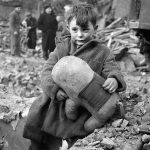 little food they had to her. I can’t imagine what must have gone through their minds. They must have agonized over the instinct to do whatever it took to keep their child alive, and wondering what would happen to her if they died and left her orphaned.
little food they had to her. I can’t imagine what must have gone through their minds. They must have agonized over the instinct to do whatever it took to keep their child alive, and wondering what would happen to her if they died and left her orphaned.
I wish there was a way to find out what happened to Lucy. I hope she had a good life with loving parents, who gave her the kind of life her own parents would have given her, had they lived. I hope she grew up to have a husband and children of her own. And I hope that her adoptive parents told her about the parents who loved her so much that they allowed themselves to starve to death, that she might live. Such a sacrifice should not go unnoticed, nor should it ever be forgotten.
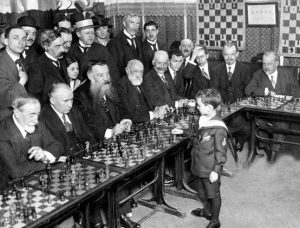 Mastery knows no age. Genius can occur in anyone, and of course, always presents itself when a child is very young. In 1920, one such genius, Samuel Reshevsky was busy mastering chess masters in France. Reshevsky learned chess when he was just 4 years old. He became known as a child chess prodigy and was playing simultaneous games of chess against adults when he was 6 years of age. At age 8 he was playing chess against strong players. Following the events of World War 1, Reshevsky immigrated to the United States. As a 9 year old, his first American simultaneous exhibition was with 20 officers and cadets at the Military Academy at West Point. He won 19 games and drew one. He toured the country and played over 1,500 games as a 9 year old in simultaneous exhibitions and only lost 8 games. In his early years he did not go to school and his parents ended up in Manhattan Children’s Court on charges of improper guardianship. In reality, little Samuel probably could have taught the teachers, so missing some of his education was not detrimental to him in any way.
Mastery knows no age. Genius can occur in anyone, and of course, always presents itself when a child is very young. In 1920, one such genius, Samuel Reshevsky was busy mastering chess masters in France. Reshevsky learned chess when he was just 4 years old. He became known as a child chess prodigy and was playing simultaneous games of chess against adults when he was 6 years of age. At age 8 he was playing chess against strong players. Following the events of World War 1, Reshevsky immigrated to the United States. As a 9 year old, his first American simultaneous exhibition was with 20 officers and cadets at the Military Academy at West Point. He won 19 games and drew one. He toured the country and played over 1,500 games as a 9 year old in simultaneous exhibitions and only lost 8 games. In his early years he did not go to school and his parents ended up in Manhattan Children’s Court on charges of improper guardianship. In reality, little Samuel probably could have taught the teachers, so missing some of his education was not detrimental to him in any way.
Reshevsky was a tough and forceful player who was superb at positional play, but could also play brilliant  tactical chess when warranted. He often used huge amounts of time in the opening, a dangerous tactic which sometimes forced him to play the rest of the game in a very short amount of time. That sometimes unsettled Reshevsky’s opponents, but at other times resulted in blunders on his part. Reshevsky’s inadequate study of the opening and his related tendency to fall into time-pressure may have been the reasons that, despite his great talent, he never became world champion; he himself acknowledged this in his book on chess upsets.
tactical chess when warranted. He often used huge amounts of time in the opening, a dangerous tactic which sometimes forced him to play the rest of the game in a very short amount of time. That sometimes unsettled Reshevsky’s opponents, but at other times resulted in blunders on his part. Reshevsky’s inadequate study of the opening and his related tendency to fall into time-pressure may have been the reasons that, despite his great talent, he never became world champion; he himself acknowledged this in his book on chess upsets.
Reshevsky never became a truly professional chess player. He gave up competitive chess for seven years, from 1924 to 1931, to complete his secondary education. He graduated from the University of Chicago in 1934 with a degree in accounting, and supported himself and his family by working as an accountant. Not everyone could leave off and then pick up their education and never miss a beat. Of course, when you have genius level intelligence, I guess that isn’t a problem.
 During the Vietnam War, as in any war, children can become displaced because of the loss of their parents. The country has already lost so many people, and often there is no one to take these little orphans, so they often end up in an orphanage, waiting for someone to come along and adopt them. Many times, they live their entire childhood in that orphanage. For a country that has already be devastated by war, the cost of raising these children is detrimental. Such was the case for orphaned children from the Vietnam War. Then the United States made the decision to airlift these children to the United States to be adopted by American families who were waiting for children. The plan was dubbed Operation Baby Lift, and while it would end up being successful, it got of the a sad and rocky start on April 4, 1975, when the first plane crashed shortly after taking off from Tan Son Nhut airbase in Saigon. On board were more than 300 passengers. Of those, 138 passengers, mostly children were killed.
During the Vietnam War, as in any war, children can become displaced because of the loss of their parents. The country has already lost so many people, and often there is no one to take these little orphans, so they often end up in an orphanage, waiting for someone to come along and adopt them. Many times, they live their entire childhood in that orphanage. For a country that has already be devastated by war, the cost of raising these children is detrimental. Such was the case for orphaned children from the Vietnam War. Then the United States made the decision to airlift these children to the United States to be adopted by American families who were waiting for children. The plan was dubbed Operation Baby Lift, and while it would end up being successful, it got of the a sad and rocky start on April 4, 1975, when the first plane crashed shortly after taking off from Tan Son Nhut airbase in Saigon. On board were more than 300 passengers. Of those, 138 passengers, mostly children were killed.
Captain Dennis “Bud” Traynor was the captain on the plane. Many of the 138 passengers were children, and  many of them were under age 2 and so small, they had to be carried onto the plane. “We bucket-brigade-loaded the children right up the stairs into the airplane,” Traynor remembers. The flight began normally, but shortly into the flight, when the plane’s cargo doors malfunctioned they blew out, taking with them a chunk of the tail. There was a rapid decompression inside the aircraft, causing the pilot, Traynor, to crash land the C-5 cargo plane into a nearby rice paddy. Traynor managed to stabilize the plane and turn it back toward Vietnam. After that, his only option was a crash landing. The impact was fierce. “It cut all control cables to the tail,” explains Traynor. “So I’m pulling and pulling and pulling, and my nose is going down further and further and we’re going faster and faster and faster, and I can’t figure this out. We came to a stop and I thought to myself ‘I’m alive,'” he says. “And so I undid my lap belt, fell to the ceiling, rolled open the side window, and stepped out and saw the wings burning. And I thought, ‘Oh no, that’s the rest of the airplane.'” Out of the more than 300 people on board, the death toll included 78 children and about 50 adults, including Air Force personnel. More than 170 survived.
many of them were under age 2 and so small, they had to be carried onto the plane. “We bucket-brigade-loaded the children right up the stairs into the airplane,” Traynor remembers. The flight began normally, but shortly into the flight, when the plane’s cargo doors malfunctioned they blew out, taking with them a chunk of the tail. There was a rapid decompression inside the aircraft, causing the pilot, Traynor, to crash land the C-5 cargo plane into a nearby rice paddy. Traynor managed to stabilize the plane and turn it back toward Vietnam. After that, his only option was a crash landing. The impact was fierce. “It cut all control cables to the tail,” explains Traynor. “So I’m pulling and pulling and pulling, and my nose is going down further and further and we’re going faster and faster and faster, and I can’t figure this out. We came to a stop and I thought to myself ‘I’m alive,'” he says. “And so I undid my lap belt, fell to the ceiling, rolled open the side window, and stepped out and saw the wings burning. And I thought, ‘Oh no, that’s the rest of the airplane.'” Out of the more than 300 people on board, the death toll included 78 children and about 50 adults, including Air Force personnel. More than 170 survived.
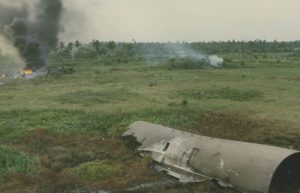 While it was an unusual plan, hatched in the midst of the political fallout, the United States government announced the plan to get thousands of displaced Vietnamese children out of the country. President Ford directed that money from a special foreign aid children’s fund be made available to fly 2,000 South Vietnamese orphans to the United States. Operation Baby Lift lasted for just ten days. Baby Lift was carried out during the final, desperate phase of the war, as North Vietnamese forces closed in on Saigon. Although this first flight ended in tragedy, the rest of the flights were completed safely, and Baby Lift aircraft brought orphans across the Pacific until the mission’s conclusion on April 14, just 16 days before the fall of Saigon and the end of the war.
While it was an unusual plan, hatched in the midst of the political fallout, the United States government announced the plan to get thousands of displaced Vietnamese children out of the country. President Ford directed that money from a special foreign aid children’s fund be made available to fly 2,000 South Vietnamese orphans to the United States. Operation Baby Lift lasted for just ten days. Baby Lift was carried out during the final, desperate phase of the war, as North Vietnamese forces closed in on Saigon. Although this first flight ended in tragedy, the rest of the flights were completed safely, and Baby Lift aircraft brought orphans across the Pacific until the mission’s conclusion on April 14, just 16 days before the fall of Saigon and the end of the war.
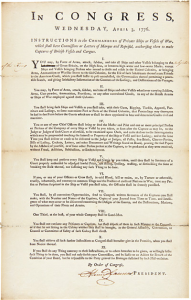 When the United States, still known as the colonies at that time, it lacked sufficient funds to build a strong navy, and with the coming Revolutionary War, they needed that strength. So, the Continental Congress gave privateers permission to attack any and all British ships. What is a privateer, you might ask? A privateer is a private person or ship that engages in maritime warfare under a commission of war.
When the United States, still known as the colonies at that time, it lacked sufficient funds to build a strong navy, and with the coming Revolutionary War, they needed that strength. So, the Continental Congress gave privateers permission to attack any and all British ships. What is a privateer, you might ask? A privateer is a private person or ship that engages in maritime warfare under a commission of war.
In a bill signed by John Hancock, president of the Continental Congress, and dated April 3, 1776, the Continental Congress issued, “INSTRUCTIONS to the COMMANDERS of Private Ships or vessels of War, which shall have Commissions of Letters of Marque and Reprisal, authorizing them to make Captures of British Vessels and Cargoes.” Letters of Marque and Reprisal were the official documents by which 18th century governments commissioned private commercial ships, known as privateers, to act on their behalf, attacking ships carrying the flags of enemy nations. As a perk, any goods captured by the privateer were divided between the ship’s owner and the government that had issued the letter.
Congress informed American privateers on this day that, “YOU may, by Force of Arms, attack, subdue, and take all Ships and other Vessels belonging to the Inhabitants of Great Britain, on the high seas, or between high-water and low-water Marks, except Ships and Vessels bringing Persons who intend to settle and reside in the United Colonies, or bringing Arms, Ammunition or Warlike Stores to the said Colonies, for the Use of such Inhabitants thereof as are Friends to the American Cause, which you shall suffer to pass unmolested, the Commanders thereof permitting a peaceable Search, and giving satisfactory Information of the Contents of the Ladings, and Destinations of the Voyages.” In many ways, this action was very similar to guerrilla warfare, except it was a battle fought on the high seas, and unlike guerrillas, these men were acting under the authority of the government…even if both were fighting for their nation.
For those who faced them on the high seas, there was no difference between pirates and privateers. They 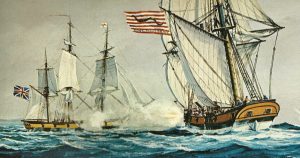 acted and operated identically, boarding and capturing ships using force, if necessary. However, privateers holding Letters of Marque were not subject to prosecution by their home nation and, if captured, were treated as prisoners of war instead of criminals by foreign nations. I wonder if their were actually pirates among he privateers. To me, it would make sense to believe that their were, but perhaps the government would not authorize known pirates to do this work. Either way, the privateer commission was a very successful form of warfare in the Revolutionary War days.
acted and operated identically, boarding and capturing ships using force, if necessary. However, privateers holding Letters of Marque were not subject to prosecution by their home nation and, if captured, were treated as prisoners of war instead of criminals by foreign nations. I wonder if their were actually pirates among he privateers. To me, it would make sense to believe that their were, but perhaps the government would not authorize known pirates to do this work. Either way, the privateer commission was a very successful form of warfare in the Revolutionary War days.
 When we think of diving suits, most of us think of the modern day neoprene wet suit, but the diving suits of the past were very different. Of course, the suits that allow divers to go deeper are much different that the more shallow-diving wet suit, but they are still vastly different that the original types of deep-diving suits that were used earlier. One of those earlier suits…the suit designed by Chester E. Macduffee looks like something out of an old movie. In fact, it reminds me of the robot on the 1965 Lost in Space series. Macduffee was an obscure inventor, who patented 4 inventions, and then disappeared from public view. There is very little information out there about him. Nevertheless, I find his 250 Kilo diving suit to be very interesting.
When we think of diving suits, most of us think of the modern day neoprene wet suit, but the diving suits of the past were very different. Of course, the suits that allow divers to go deeper are much different that the more shallow-diving wet suit, but they are still vastly different that the original types of deep-diving suits that were used earlier. One of those earlier suits…the suit designed by Chester E. Macduffee looks like something out of an old movie. In fact, it reminds me of the robot on the 1965 Lost in Space series. Macduffee was an obscure inventor, who patented 4 inventions, and then disappeared from public view. There is very little information out there about him. Nevertheless, I find his 250 Kilo diving suit to be very interesting.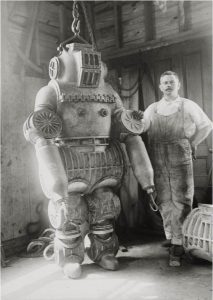
Macduffee’s Armored Diving Suit was tested in 1915 in Long Island Sound. It was made from aluminum alloy and weighed about 250 kilo, which is 551 pounds. The cylindrical joints were mounted on ball bearings to allow movement, but in one direction only. They were not watertight, so Macduffee put a waterpump into the suit. This pump was able to pump water from the leg section into the sea. The pump operated on compressed air supplied from the surface. The used air from the pump then expanded into the suit and was used by the diver for breathing. The pump was driven by electricity…another factor that would make me nervous. The idea of mixing water and electricity to that degree would make me extremely nervous. The suit was equipped with a 12 section-gripper mounted on 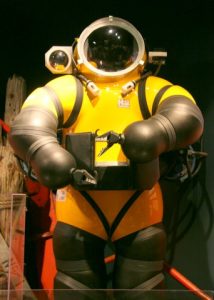 one arm and a electric light on the other arm. as well as a hook on one arm. Macduffee’s suit reached 65 meters, or 213 feet, of waterdepth in 1915! Pretty amazing distance for that era. The current diving suits reach distances of about 2,000 feet, making the Macduffee suit a shallow water suit, in reality.
one arm and a electric light on the other arm. as well as a hook on one arm. Macduffee’s suit reached 65 meters, or 213 feet, of waterdepth in 1915! Pretty amazing distance for that era. The current diving suits reach distances of about 2,000 feet, making the Macduffee suit a shallow water suit, in reality.
The diver got in the suit, and then the suit was lowered down by way of a cable. I wonder what the first diver thought of all that. Testing the suit must have been a little bit scary, because of course, they didn’t fully know how the suit would do in the deep water. I’m sure it occurred to them that they could be crushed. One thing is for sure, if a shark bit him, I think the shark would be the one who was surprised, especially when some of their teeth came out. Modern-day deep diving suits don’t look all that different when you think about it, but they are much easier to use.
 When I think of Easter, I immediately think of my Christian faith. I think of the miracle of salvation, and the willing sacrifice of our Lord and Saviour Jesus Christ. The human race was in so much trouble. Sin had entered in and we were doomed. There was no way out, because the wages of sin is death and all has sinned. But God has a solution. Innocent blood must be shed to pay the price for all those who had sinned. There was not other way to reverse the curse that sin had brought sin the world.
When I think of Easter, I immediately think of my Christian faith. I think of the miracle of salvation, and the willing sacrifice of our Lord and Saviour Jesus Christ. The human race was in so much trouble. Sin had entered in and we were doomed. There was no way out, because the wages of sin is death and all has sinned. But God has a solution. Innocent blood must be shed to pay the price for all those who had sinned. There was not other way to reverse the curse that sin had brought sin the world.
The death of Jesus, on Good Friday, was a brutal one. As we know, humans have the ability to inflict horrible pain and wounds upon one another. Jesus was a man, but he was also God. He felt every brutal flogging, and endured every humiliation that was thrust upon him, and he did it knowing that it was vital. In fact it was the most important mission in history…past, present, and future. No single act would ever be more important, because the death on the cross was a “once for all” thing. His death reversed history. What the devil stole from the human race, Jesus returned.
When Jesus arose from the dead, three days later, our justification was complete. We could now go to Heaven,  just by believing that Jesus had made that sacrifice for us, and accepting him as our Lord and Saviour. Such a simple way to receive eternal life, and yet, so many people refuse to receive, because they think they will have to give up their fun life. Little do they know what they are really giving up. This life is just a moment in time…Heaven is forever. The difference is stark. This life is fleeting and soon will be gone, but the next life will never end, and we can choose where we spend it, so we must choose wisely.
just by believing that Jesus had made that sacrifice for us, and accepting him as our Lord and Saviour. Such a simple way to receive eternal life, and yet, so many people refuse to receive, because they think they will have to give up their fun life. Little do they know what they are really giving up. This life is just a moment in time…Heaven is forever. The difference is stark. This life is fleeting and soon will be gone, but the next life will never end, and we can choose where we spend it, so we must choose wisely.
Many people celebrated with a big dinner, and Easter candy, and that is fine but people should never forget the real reason we celebrate Easter…the resurrection of Jesus, our Lord and Saviour. Jesus is risen!! He is alive!! Happy Easter everyone!!

